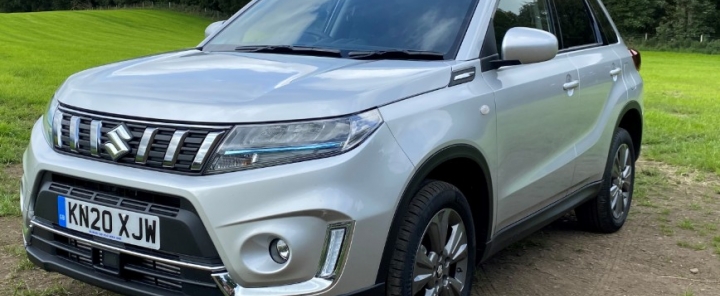Looking for a Vehicle Valuation or hpi check?
Suzuki Vitara SZT Hybrid Test Car

The Vitara was launched in 2015 and had styling and safety updates in 2019, proving to be a popular compact SUV. The new 2020 model now offers a higher level of standard specification and hybrid technology is now fitted as standard.
We have our own 2017 Vitara, so I’m very used to driving this Suzuki, but the very first thing I noticed when the hybrid test car arrived was the difference in how the doors and boot close. The 2020 model just feels so much more solid, the difference in sound and feel when closing the doors is so much improved, not quite sure how they have done that, but it’s impressive.
The Vitara styling is good, and has loads of character. I remember on the original launch five-years ago, just how much the sloping roof resembled the Range Rover Evoque, maybe just a coincidence or did Suzuki deliberately copy this bit of clever design to enhance its appeal and make it look more like the premium Land Rover? We may never know, but it certainly hasn’t been a bad thing.
The Hybrid system is basically a mild-Hybrid and consists of a 48V lithium-ion battery, integrated Starter Generator (ISG) and 48V-12V (DC/AC) converter to power components requiring low voltage, including lights, audio and air conditioning. The ISG acts as both generator and starter motor. This assists the petrol engine during acceleration. If that is a bit too technical or complicated, then here is the simplified version. As you decelerate or brake, the car produces energy and this energy is saved in the lithium-ion batteries. This stored electricity is then used through an electric motor to help produce power when accelerating. This saves the engine needing to be used as much and thus saves fuel and reduces C02 emissions. To put it even more simply: Don’t worry about it, the car does all the work and thinking.
During the week I had the car, I saved a considerable amount of petrol by this system and the engine was turned off for a total of 24 minutes whilst I stopped in traffic.
There are three models in the Vitara range: SZ4, SZ-T and SZ5, after looking at the difference in specification, for me, the middle model is the best one to have.
The SZ-T is fully loaded with standard equipment and technology, and has one thing I wished our Vitara has, a front centre arm rest, something I miss. But the list is so long and does include: Sat Nav, Adaptive Cruise Control, Air-Con, Traffic Sign Recognition, rear parking camera (though I prefer audible parking sensors), airbags everywhere, and so the list goes on.
The Vitara is powered by a 1,373 cc, or 1.4-litre petrol engine that produces 129PS and accelerates from 0-62 mph in a respectable 9.5 seconds. It has CO2 emissions of 128g/km (WLTP). The car I had on test had a very smooth 6-speed manual gearbox. The overall length of the Vitara is 4,175mm, and is 1,775mm wide, so is very manoeuvrable and easy to park.
On the motorway I took advantage of the Adaptive Cruise Control. I have used this technology so many times in various cars, but I am always, initially wary and a bit scared by it. You set your maximum speed, which of course is 70mph in the UK. You select the distance you want to maintain between you and the vehicle in front. Take your foot off the accelerator, and let the car do all the work. The Vitara will keep up with the car or truck in front, if it slows down, you slow down, if it speeds up, you speed up> It’s that simple, but, you can’t help having your right foot hovering over the brake pedal, just in case. The problem is, the system never misses anything, it sees things before you do – how very, very annoying!
The cost of the Vitara 1.4 Boosterjet Hybrid in the UK is £22,749, which does look good value for this small, competent, well built SUV.
Martin Ward
Let's keep in touch.
Thanks for signing up.
Join our mailing list to keep up to date on the latest news, reviews and insights.